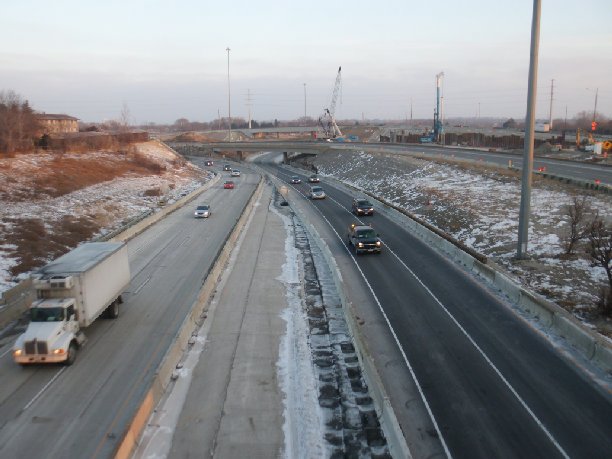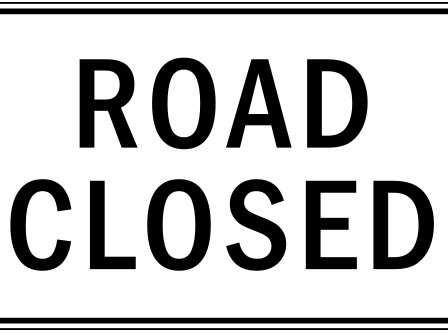With gas prices on the rise and new policies and ideas on the table, it's time to look at how we get around. We all need to get someplace and we use many different modes of transportation to do so. As we kick off 2011 at OnMilwaukee.com, we're taking an in-depth look at how we get around with a special "Transportation Week," featuring all kinds of stories about how Milwaukee gets where it's going. So, buckle up, hop on and all aboard.
As the old joke goes, there are two seasons in Wisconsin: winter and construction.
As the Southeast Wisconsin freeway system nears the end of its useful life, a number of major road construction are in progress or planned for the near future.
The biggest project is already underway, a complete reconstruction of the Mitchell Interchange. Included in that project are rebuilds of the Plainfield Curve, the Airport Spur and numerous bridges, on- and off-ramps.
"It's a complete reconstruction," says Ryan Luck, Southeast Wisconsin Freeway Construction Chief for the Wisconsin Department of Transportation. "When finished, there will be all new roadway surfaces and bridges. All of the existing freeway will be removed, crushed and recycled as much as possible into the new roadway."
Safety first
The $162 million project -- part of a $1.9 billion project rebuilding the entire I-94 corridor between the Mitchell Interchange and the Wisconsin-Illinois state line -- began in 2009 and will be complete in 2012. The new roadway will be much safer than it's predecessor, eliminating a number of left-hand ramps, adding "clear zones" -- which allow an out-of-control vehicle to safely exit and re-enter traffic -- and new, single slope concrete safety barriers.
"All of our new safety features are consistent with Federal Highway Administration standards," Luck says.
Milwaukee drivers will feel the biggest impact in and around the Mitchell Interchange, which serves as a junction for the North-South Freeway (US 41/I-94) and the Airport Freeway (I-43/I-894).
All the bridges and ramps in the interchange are being rebuilt, including three tunnels which will carry traffic through the interchange. Two of the tunnels will carry motorists between I-43/894 and I-43/94 while a third will connect traffic coming north on I-94 to westbound I-43/894.
"Tunnel systems were the most economical choice and the best fit for this location," Luck says.
Construction of the tunnels is underway and will continue throughout the year. The final year of the project will focus on a number of connector ramps in the area and the S. 27th Street interchange, which is a focal point of the project.
The S. 27th St. corridor is one of the busiest in the Milwaukee area and will also be completely rebuilt. A first-of-its-kind "U Ramp" will be built at 27th Street, allowing traffic to keep moving through the corridor without interruption from traffic trying to exit or enter the freeway.
All traffic will enter the freeway by a right-hand turn off 27th Street. The only cross-traffic will come from vehicle exiting the freeway and making a left-hand turn on to South 27th Street.
"South 27th Street is a very important corridor and these changes should allow for better free flow of movement," says WisDOT Southeast Freeways Design Director Bob Gutierrez.
Further south, the project will build new roadway between the state line and Milwaukee county while also eliminating a number of dangerous "braided ramps" along the corridor, upon which traffic from the freeway exits onto a frontage road, from which traffic is also trying to enter the freeway.
"It seemed like a very intuitive design at the time but it's not considered acceptable now," Luck says. "All aspects of this project are in line with federal guidelines for consistent safety designs."
During the project, WisDOT maintains a Web site providing specific information to motorists and area residents.
I-94 resurfacing starts in March
Travelers on the East-West Freeway will be in for a challenge this summer when work begins on resurfacing the heavily-traveled route between Downtown and Waukesha County.
The $44 million project will take two years to complete in Milwaukee County, while work in Waukesha County, between WIS 16 and the county line will be completed this summer.
The Milwaukee segment will get underway in March. The current road surface will be removed and the underlying base will be compacted into gravel, upon which the new roadway will be built, according to Gutierrez.
Planning for the resurfacing was done with other projects on mind. WisDOT chose to work on the westbound lanes first because a key ramp in the Mitchell Interchange, from EB I-894 to northbound I-43/94 will be closed for much of the year. A large volume of traffic which would normally use that route to access Downtown will instead be turning to eastbound I-94.
This is the third resurfacing project for the East-West freeway since it was completed in the 1960s. The first was done in the late '70s and another was completed between 1997-'98.
The new surface is expected to last 12-15 more years, at which time WisDOT will consider whether to do another replacement or completely rebuild the heavily-traveled roadway.
During the project, traffic during peak travel times is expected to be reduced to two lanes. Approximately 170,000 vehicles use that stretch of I-94 on a daily basis.
WisDOT is hoping to reduce that number by 50 percent during the project, with the hopes that motorists turn to local roads or use public transportation.
All of the projects, both planned and underway, reflect a new philosophy in road construction.
The new roadways in the Mitchell Interchange project will utilize a 41-inch thick, "perpetual pavement" design.
Perpetual Pavement uses multiple layers of asphalt, starting with a strong but flexible base layer that resists traffic strain and preventing base cracks. The original Milwaukee freeway segments, as in most of the United States, used a 12-inch thick design -- often with asphalt on top.
The design is similar to what's used in Europe, where a more costly up-front investment is used in a longer-lasting roadway.
"This is a very strong and durable pavement, consistent with what we've been doing in other large projects like the Marquette Interchange," Luck says. "We want to do it once, make it right and make it last."
Additionally, construction today includes "green" practices like roadway recycling. Pavement is crushed on site and, instead of being trucked away from the work zone, it is crushed on-site into gravel that is used for the sub-base or in the new road surface. Reinforcing steel rods are separated from the rubble and taken to a scrap yard for further recycling.
"It's a win-win for everybody," Luck says. "It keeps the costs down for the state and many of the contractors prefer to bring the machines in to recycle the materials right there.
"It's better for the environment, too. In all of our projects, we strongly encourage the recycling of materials."
Keeping traffic flowing
To help motorists navigate through the road work projects, WisDOT has expanded its traffic monitoring programs. The Statewide Traffic Operations Center, located in the Milwaukee Inter modal Station, maintains around-the-clock monitoring of the state's highway system with a large network of cameras and sensors.
The STOC uses data collected to update drivers via large, electronic overhead signs and the growing 511 system, which provides traffic information to motorists either via the Web or their phones.
"Travelers expect on-demand information, whether it's by signage, using their phones or their computers," says WisDOT's Emlynn Grisar. "It's technology that we didn't have five years ago."
Many of WisDOT's new practices came as a result of the very successful Marquette Interchange project, which was completed in 2008.
At the time, it was the largest construction project in state history and it set the bar high for future projects. The four-year, $800 million reconstruction was finished ahead of schedule and under budget, two key goals of any WisDOT project moving forward.
Luck says the department's goals are to finish projects on time, with the budget, safely, and with the community.
"Whatever we take on, those are our points of emphasis," he says."
Other WisDOT updates
Hoan Bridge
A $7.5 million pavement repair will continue this year, beginning in March, to resurface a 2.5-mile stretch of the bridge. Greisar says most lanes will remain open during the project. While the bridge's future has been in question, there currently is no action being taken on any of the studies regarding the bridge's future.
Lake Parkway
Recently extended to S. Pennsylvania Ave. in Cudahy, the Southeast Wisconsin Regional Planning Commission recently completed a study on the possibility of extending the parkway further south into Racine County.
A number of communities along the route, along with Milwaukee city and county leaders have endorsed an extension but as of this time, WisDOT does not own any real estate or right of way to facilitate construction.
Zoo Interchange
There is also no timetable on reconstruction the Zoo Interchange, the busiest in the state. The I-94 resurfacing will not impact the interchange at all, leaving it to be address in a later project.
Last summer, deterorating conditions required an emergency replacement of three key bridges in the interchange and though they were considered "temporary," Luck, the project manager, says they are structually sound and built to last.
"They were designed to last about 20 years," Luck says. "They are real ramps; safe, strong ramps that will allow travelers to keep using the interchange."
The "temporary" label is kind of a misnomer. The bridges were built to federally-mandated specifications, though lack the asthetic value of similar facilities in the Marquette or Mitchell Interchanges.
"We made them functional," Luck says. "They simply serve the purpose of keeping the traffic flowing."
The ramps will be removed when the Zoo Interchange is rebuilt as they won't fit into a new design scheme.




